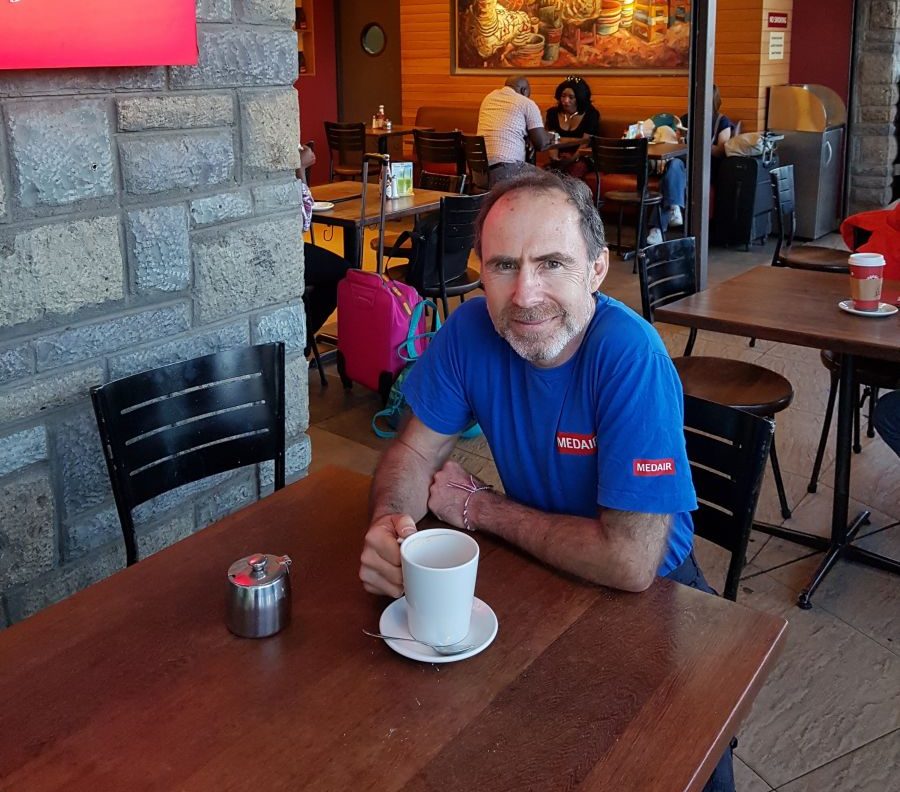Process Excellence and the CHS: what are the similarities? – Coffee with Andrew Parris, Medair, Switzerland
In our previous coffee with Andrew, he shared how the similarity between community development and his area of expertise – Lean – led him to join World Vision in 2008 and Medair in 2017. In this virtual coffee with him, we explore the alignment between Process Excellence and the Core Humanitarian Standard on Quality and Accountability (CHS).

In our previous coffee with Andrew, he shared how the similarity between community development and his area of expertise – Lean – led him to join World Vision in 2008 and Medair in 2017. This time we had a virtual coffee with Andrew in Nairobi, on his way back from South Sudan, where Medair had just carried out a series of CHS self-assessment interviews with beneficiaries, staff, a partner, and even a donor. Together we explored the alignment between Process Excellence and the Core Humanitarian Standard on Quality and Accountability (CHS).
Andrew, when you joined World Vision, how did you adapt Lean from the corporate world into the NGO context?
Based on the inherent alignment between Lean and World Vision’s approach to community development, I defined what I call Process Excellence. This vision of what an excellent process looks like integrates the priorities of Lean – being Effective and Efficient – with the priorities of development and humanitarian work – being Appropriate and Empowering. Over all these, I laid Continuously Improving, to come up with five elements of Process Excellence (see diagramme). Since coming to Medair, I modified it very slightly to address the focus of humanitarian work: relief and recovery.
I already see some similarities, but first let me ask you: Why did you choose to focus on Process Excellence?
Ah, yes. I focused on Process Excellence because nearly everything we do in an NGO we do through processes: performing assessments, writing proposals, hiring staff, procuring goods and services, and paying invoices, to name a few. Processes are how we do our work. And the quality of our processes determines the quality of our work. So, if we want excellent results, we must have excellent processes.

Makes sense. So, what are some of the key areas of alignment that you see between CHS and Process Excellence?
Let’s look at Commitments 1 and 9, although I see alignment across the board.
CHS Commitment #1 states that “Communities and people affected by crisis receive assistance appropriate and relevant to their needs.” In Process Excellence, Effective means (in part) that the process output and impact are valuable to the customer – in this case, to the beneficiaries. Lean is all about providing customer value and eliminating the waste in our processes that hinder the creation and delivery of value. So, an excellent process will provide assistance that is valuable – appropriate and relevant to the community’s needs.
Commitment #9 states, “Communities and people affected by crisis can expect that the organisations assisting them are managing resources effectively, efficiently and ethically.” Effective and Efficient are the two top elements of Process Excellence. Ethical connects with the Process Excellence idea of respecting all stakeholders in Appropriate.
That all sounds a bit technical. Can you summarize the alignment simply?
Sure. A humanitarian organisation that has excellent processes delivers the greatest value (impact) to the beneficiaries it serves. It efficiently provides effective assistance that is appropriate and empowering. And it continuously improves. Pursuing Process Excellence strengthens an organisation’s ability to fulfil the CHS commitments.
In our next chat with Andrew we will find out what we can learn from the corporate world, and possibly, import into the humanitarian and development sectors…
